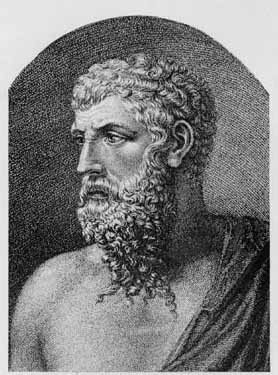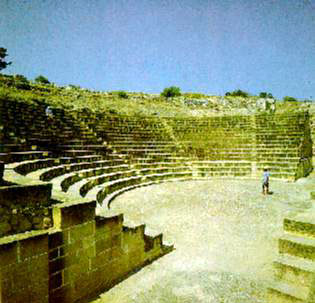HISTORY OF DRAMA
The origins of drama take root in Greek history around the era of 700 BC. Greeks honoured their gods by holding grand festivals. The people of Athens held an annual fertility festival in March devoted to the god Dionysus, where, for one whole week, men would dress up in rough goat skins (ie: goats were thought to be sexually potent) and simply gorged themselves on wine. They would strut about and sing and chant (these songs and chants were known as ‘dithyrambos’) to welcome Dionysus. The one simple rule was you had to be drunk.
As Dionysus was the god of sexuality, these religious rituals also celebrated the phallus (or penis). By today’s standards, we would think these ceremonies were simply crude, vulgar and disgusting. What began as just random, frenzied improvisations of song and dance, these religious rites eventually came to be written down in verse form and later took on a more structured format. This is how the art of the ‘play’ was formed.
Wealthy men sponsored the plays by paying a special tax. They hoped the success of the play they sponsored would help them get into politics.
Of the four festivals in Athens (each reflecting seasonal changes), plays were only presented at one festival – the City Dionysia. Various tribes in Greek society competed fiercely against each other in these performances, and the best show would be declared the winner.
Historians believe that the Greeks patterned their celebrations in a way similar to that of the traditional Egyptian pageants that honoured their god - Osiris.
HOW DRAMA CHANGED?
Then, in the era of 500 BC, a poet named Thespis invented a new style of performance where an individual actor performed the speeches of characters in the narrative (using masks to distinguish between different characters). The single actor (the protagonist) spoke and acted as if he was the character, and he interacted with the chorus.
Thespis amazed the audience by leaping on the back of a wooden cart and reciting poetry. He is therefore considered the first Greek "actor," and his style of drama became known as tragedy, which means 'goat song', perhaps referring to goats sacrificed to Dionysus before performances, or to the goat-skins worn by the performers.
While it is uncertain whether Thespis was a playwright, an actor or a priest, it is his name with which the dramatic arts are associated in our word "Thespian".
In 471 BC, another dramatist - Aeschylus – introduced a second actor, thus making dialogue between characters possible onstage.
Then, around 468 BC, Sophocles introduced a third actor making more complex dramatic situations possible. Three actors subsequently became the standard convention (actors could still play more than one character, distinguishing between them with masks).
Men acted out all the parts of the drama, even the female roles, which were played by males before they hit puberty and before their voices changed. They wore masks that represented their character. The masks showed various emotions such as grief, anger, tiredness, fear or happiness.
WHAT WAS THE CHORUS?
The chorus (or a group of performers) was a key component of the play. The chorus would sing, or dance, or narrate, or reflect on the action happening on stage. They were like extras, and would also sometimes improvise where a scene might require a random crowd.
Without the chorus, the audience would have no background information, and the play would be confusing. In fact, the way a chorus reacted to events in the play was seen as a clue to how the audience should respond.
Misconceptions about Ancient Greek Theatre
People once thought that the ancient Greek theatre consisted of nothing more than white buildings with white scenes and white clothing. This idea came to be formed when European explorers found theatre ruins that were abandoned, crumbling and totally devoid of colour. These theatres, however, were only colourless because the colours on the ruins had faded over the years. The ancient Greek theatre actually consisted of loud music, bright colours and extensive dancing.
Greek plays showed:
* violence and daily life
* social and ethical plays
* war
* murder
* lust
* betrayal
WHO WROTE GREEK DRAMA?
TRAGEDY
Three well-known Greek tragedy playwrights of this era are Aeschylus, Sophocles and Euripides.
Aeschylus who was a competitor at the City Dionysia around 499 BC and wrote some of the oldest tragedies in the world. Only a few of Aeschylus' plays have survived. He is famous for introducing the 2nd actor to the stage – this character is called the antagonist.
Another Greek playwright was Sophocles, and only seven of his tragedies (Oedipus Rex being the best known) have survived. Sophocles won 24 contests for his plays, never placing lower than second. His contributions to theatre history are many: He introduced the third actor to the stage, fixed the number of chorus members to 15, and was the first to use scene painting.
Euripides was another prolific playwright who is believed to have written 90 plays, 18 of which have survived, including Medea and Hercules. He was often criticized for the way he questioned traditional values on stage. Euripides also explored the psychological motivations of his characters' actions.
Although few tragedies written from this time actually remain, the themes of Greek tragedy still register with modern audiences. Most Greek tragedies are based on significant worldly things such as love, loss, pride, the abuse of power, a search for meaning or stories about ‘gods and men’.
Often in tragedies, the hero is flawed with one or more weaknesses. Throughout the course of the drama, the hero struggles to achieve his objectives, which involves overcoming obstacles placed in his path. The hero is normally defeated and as a result of this, the play ends in unfortunate circumstances.
Greek tragedies usually followed a well-known formula set down by the philosopher Aristotle in his work ‘The Poetics’ (330 BC). He demanded that the tragedy must be formal, must end with a satisfying resolution and must be of great moral significance for the people of Greece. Further, he insisted that all the action of the tragedy occurs within a single day in the plot. Conflict had to be an essential ingredient. Aristotle saw tragedy in drama as an important benefit to society, as it meant that by the end of a play an audience would have been made to release a whole range of healthy human emotions – a kind of cleansing experience.
COMEDY
Comedy was also an important part of ancient Greek theatre. No one is quite sure of the origins of comedy, but it is said that they derived from imitation. All comedies were written by Aristophanes. He competed in the major Athenian festivals, wrote 40 plays, 11 of which survived, including the most controversial piece of literature to come from ancient Greece, Lysistrata, which was a humorous tale about a strong woman who leads a female alliance to end war in Greece. Comedies generally mocked men who held positions of power. Although only a few dramatic plays remain from such a creative period, the Greeks were responsible for the birth of drama in the Western world.
WHERE WERE GREEK PLAYS HELD?
Greek theatre took place in large hillside arenas. The Greeks built outdoor semi-circular sites called amphi-theatres. The first theatres were built of wood. Later, stone theatres were constructed. The seats were stone and carved into a hill. Unlike modern theatre, the seats weren’t set up so that the better seats were all together, and the worse seats were all together.
Instead, every Greek "tribe" sat in a different section. The front rows were reserved for the priests. The lay audiences were in the section for their tribe. Greek theatres were not enclosed; the audience could see each other and the surrounding countryside as well as the actors and chorus.
Originally the theatre was made to hold religious ceremonies. It consisted of 3 principal elements: the orchestra, the skene, and the koilon.
The koilon (the audience seating area) was built on a hillside that sloped down to a round stage. This circle area was where the chorus danced and sang. In the centre of the stage was an altar dedicated to the beloved god Dionysus. These theatres were very large. The theatres in Athens and Epidaurus could hold 15,000 and the one in Argos seated 20,000.
The actors came in and out of doors in the back wall of the stage called the skene. This door was painted to look like the play's setting. The props were painted pieces that could be turned on axles. The actors could also swing on cables.
Inside a permanent skene, were machines. One machine (the Aeorema) was a crane that enabled the gods to appear on the stage.
Another machine (the Periactoi) was placed inside pillars on the left and right side of the stage. It changed the background of the skene.
The last machine used was the Ekkyklema, a platform on wheels to bring the bodies of the dead out to show the audience. This was necessary since murder and suicide never took place in front of the audience.
The players included a chorus and their leader, and the "lines" were more chanted than spoken. The chorus performed in the "orchestra", not on a raised stage.
The Stage
Some historians say that the stage was originally a rectangle, and then became a circle. Others say that the stage has always been a circle. The stage was against the back wall. It was a narrow, raised platform. It was designed so that the actors could be separated from the chorus.
With such a large space to fill, Greek actors could not be subtle in their acting. They had to gesture grandly so that the entire audience could see and hear the story. However, most Greek theatres were cleverly constructed with acoustics in mind to transmit even the smallest sound to any seat. At the theatre in the town of Epidaurus, the tiny sound of a coin being dropped could be heard from even the highest row.
The Greeks' understanding of acoustics compares very favourably with the current state of the art, as even with the invention of microphones, there are very few modern large theatres that have truly good acoustics.
Generally speaking, the actors were so far away from the audience that without the aid of exaggerated costumes and masks, they would be difficult to see. So actors had to wear thick boots to add to their height and gloves to exaggerate their hands so that their movements would be discernible to the audience.
Distinctive masks were made for each character in a play. Masks were made of linen or cork. Tragic masks carried mournful or pained expressions, while comic masks were smiling or leering.
An actor's entire head was covered by his mask. In fact, the shape of the mask amplified the actor's voice, making his words easier for the audience to hear. To enhance visibility, actors also wore long robes with vertical stripes. To be able to tell the various actors apart, the female masks had bigger mouths and eyes.
Other Sites:
http://theatresuperstitions.blogspot.com/
http://get-up-and-run.blogspot.com/
http://filmpitch.blogspot.com/
http://filmcrewproductionroles.blogspot.com/
http://propaganda-tech.blogspot.com/
http://thewesterngenre.blogspot.com/
http://thefrenchnewwave.blogspot.com/
http://whyproductplacement.blogspot.com/














